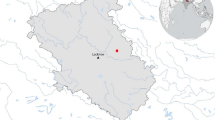Abstract
Around 100 reported species of Physaloptera commonly infect mammals, reptiles, birds, and amphibians. The identification of Physaloptera species solely on morphological characteristics is difficult, especially in the case of larval and congeneric infections. The present study is an attempt to identify molecularly and to perform phylogeny and pathology of natural Physaloptera larval infection in northern palm squirrels. The molecular confirmation of the recovered parasitic stages was performed by targeting the nuclear 18S rRNA gene sequence. Phylogenetic analysis and evolutionary divergence of the present study isolate with GenBank™ archived Physaloptera sequences were performed. The cysts (containing the larval stages) were subjected to histopathological examination. Morphological identification of the larval stages revealed the presence of pseudolabia, two spines, and a collar-like projection at the anterior end. Histopathology of the cysts revealed transverse sections of parasites in the lumen along with the thickened cystic wall, infiltration of mononuclear cells, fibrous tissue proliferation in the wall, and cellular debris in the cystic lumen. The molecularly confirmed and sequenced present study isolate was submitted to GenBank™ under the accession number LC706442. Blast analysis revealed 96.82–98.64% nucleotide homology of the present study isolate to the GenBank™ archived Physaloptera sequences. The isolate of the present study was monophyletic with Physaloptera sp. and P. praeputialis recovered from the cats of Haryana, India. Also, evolutionary divergence studies revealed no difference among these sequences. The present study evinced the most probable role of the northern palm squirrel Funambulus pennantii as an aberrant or second intermediate host for P. praeputialis.

Similar content being viewed by others
Data availability
All data generated and analyzed during this study was included in the article. However, raw data is available from the authors.
References
Anderson RC, Chabaud AG, Willmott S (2009) Keys to the nematode parasites of vertebrates. Archival volume. 463 pp. CABI Publishing, Wallingford, UK
Boggs JP, Peoples AD, Lochmiller RL (1990) Occurrence and pathology of Physalopterid larvae infections in Bobwhite quail from western Oklahoma. Proc Okla Acad Sci 70:29–31
Dixon JM, Roberson JH (1967) Aberrant larvae of Physaloptera sp. in a quail (Colinus virginianus). Avian Dis 11:41–44
Hall TA (1999) BioEdit: a user-friendly biological sequence alignment editor and analysis program for Windows 95/98/NT. Nucleic Acids Symp Ser 41:95–98
Kalyanasundaram A, Henry C, Brym MZ, Kendall RJ (2018) Molecular identification of Physaloptera sp. from wild northern bobwhite (Colinus virginianus) in the Rolling Plains ecoregion of Texas. Parasitol Res 117(9):2963–2969. https://doi.org/10.1007/s00436-018-5993-5
Luna LG (1968) Manual of histological staining methods of pathology. McGraw Hill Book Company, New York
Maharana BR, Gupta S, Gupta S, Ganguly A, Kumar B, Chandratre GA, Bisla RS (2021) First report of molecular and phylogenetic analysis of Physaloptera praeputialis in naturally infected stray cats from India. Parasitol Res 120(6):2047–2056. https://doi.org/10.1007/s00436-021-07163-2
Maldonado A, Simoes RO, Luiz JS, Costa-Neto SF, Vilela RV (2019) A new species of Physaloptera (Nematoda: Spirurida) from Proechimys gardneri (Rodentia: Echimyidae) from the Amazon rainforest and molecular phylogenetic analyses of the genus. J Helminthol 94:e68
Moudgil AD, Nehra AK, Nehra V, Sharma R, Vohra S, Moudgil P (2021) Phylogenetics and pathology of hydatid disease in slaughtered buffaloes of north India. Acta Parasitol 66(3):899–906. https://doi.org/10.1007/s11686-021-00348-w
Parihar A, Nama HS (1978) Physaloptera funambuli sp. n. (Nematoda, Physalopteridae) from Funambulus pennanti. Curr Sci Bangalore 47:832–834
São Luiz J, Simões RO, Torres EL, Barbosa HS, Santos JN, Giese EG, Rocha FL, Maldonado A Jr (2015) A new species of Physaloptera (Nematoda: Physalopteridae) from Cerradomys subflavus (Rodentia: Sigmodontinae) in the Cerrado Biome, Brazil. Neotrop Helminthol 9:301–312
Schmidt GD, Roberts LS (2009) Foundations of Parasitology, 8th edn. McGraw Hill, New York
Tamura K, Nei M, Kumar S (2004) Prospects for inferring very large phylogenies by using the neighbor-joining method. Proc Natl Acad Sci USA 101(30):11030–11035. https://doi.org/10.1073/pnas.0404206101
Tamura K, Stecher G, Kumar S (2021) MEGA 11: molecular evolutionary genetics analysis version 11. Mol Biol Evol 38(7):3022–3027. https://doi.org/10.1093/molbev/msab120
Taton-Allen G, Cheney J (2001) Gastrointestinal parasites. In: Lappin MR (ed) Feline internal medicine secrets. Hanley & Belfus Inc, Philadelphia, pp 85–95
Yamaguti S (1961) Systema helminthum-nematodes. Interscience Publishers Inc, New York, p 1261
Acknowledgements
The authors are thankful to the Dean, College of Veterinary Sciences, and Director of Research, Lala Lajpat Rai University of Veterinary and Animal Sciences, for providing the necessary facilities to carry out the research.
Author information
Authors and Affiliations
Contributions
A. D. M. was involved in sample collection, investigation, methodology, phylogenetics, and drafting the manuscript. A. K. N. was involved in sample collection, investigation, and laboratory work (identification of parasites). S. V. was involved in supervision and editing. V. N. and D. L. were involved in laboratory investigations primarily histopathological studies and also edited the manuscript. All the authors contributed to the review.
Corresponding author
Ethics declarations
Ethics approval
No studies involving laboratory animals or invasive techniques were conducted. The samples were collected from road-killed squirrels.
Consent to participate
All authors consent to participate in this publication.
Consent for publication
All authors consent to publish the manuscript.
Conflict of interest
The authors declare no competing interests.
Additional information
Handling Editor: Una Ryan
Publisher's note
Springer Nature remains neutral with regard to jurisdictional claims in published maps and institutional affiliations.
Supplementary information
Below is the link to the electronic supplementary material.
Rights and permissions
Springer Nature or its licensor (e.g. a society or other partner) holds exclusive rights to this article under a publishing agreement with the author(s) or other rightsholder(s); author self-archiving of the accepted manuscript version of this article is solely governed by the terms of such publishing agreement and applicable law.
About this article
Cite this article
Moudgil, A.D., Nehra, A.K., Vohra, S. et al. First record of molecular and pathological investigations of physalopterid larvae infection in northern palm squirrel Funambulus pennantii. Parasitol Res 122, 1671–1675 (2023). https://doi.org/10.1007/s00436-023-07873-9
Received:
Accepted:
Published:
Issue Date:
DOI: https://doi.org/10.1007/s00436-023-07873-9




